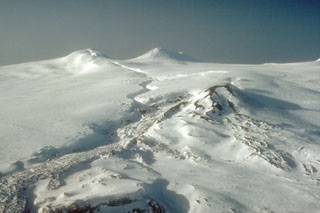Report on Westdahl (United States) — January 1992
Bulletin of the Global Volcanism Network, vol. 17, no. 1 (January 1992)
Managing Editor: Lindsay McClelland.
Westdahl (United States) Eruption apparently ends; seismic data from eruption onset
Please cite this report as:
Global Volcanism Program, 1992. Report on Westdahl (United States) (McClelland, L., ed.). Bulletin of the Global Volcanism Network, 17:1. Smithsonian Institution. https://doi.org/10.5479/si.GVP.BGVN199201-311340
Westdahl
United States
54.516°N, 164.65°W; summit elev. 1563 m
All times are local (unless otherwise noted)
Westdahl's eruption appears to have stopped. Poor weather limited observations and the stop date is uncertain, but a significant decrease in eruption intensity was noted on 15 January. Geologists noted that comparison with the 1978 eruption suggested that this cessation in activity may be only a pause.
No plume penetrated the cloud deck that obscured the summit-area fissure during a 23 January overflight. The lava flow appears to have widened to cover 2-3 times its 3 December area (figure 5), while its front had not advanced significantly. As of late January, infrared images from the NOAA-11 polar orbiting weather satellite indicated a "warm" spot in the vicinity of the volcano. Exact registration of the warm area has been difficult, but it is believed to be associated with the position of the cooling lava flow. The FAA removed all flight restrictions around the volcano on 7 February. During aerial observations by FWS personnel on 13 February, only scattered steaming was noted from the flow. Minor steaming occurred from a small cinder cone near a steep, ice-walled canyon, where the fissure vent cuts the E part of the summit glacier.
Geological Summary. Westdahl is a broad glacier-covered volcano occupying the SW end of Unimak Island. Two peaks protrude from the summit plateau, and a new crater formed in 1978 cuts the summit icecap. The volcano has a somewhat of a shield-like morphology and forms one of the largest volcanoes of the Aleutian Islands. The sharp-topped, conical Pogromni stratovolcano, 6 km N, rises several hundred meters higher than Westdahl, but is moderately glacially dissected and presumably older. Many satellitic cones of postglacial age are located along a NW-SE line cutting across the summit of Westdahl. Some of the historical eruptions attributed to the eroded Pogromni may have originated instead from Westdahl (Miller et al. 1998). The first historical eruption occurred in 1795. An 8-km-long fissure extending east from the summit produced explosive eruptions and lava flows in 1991.
Information Contacts: AVO.

